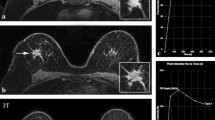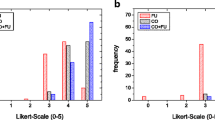Abstract
The purpose was to combine T1-weighted 3D gradient echo sequences at low and high spatial resolution (and short and longer acquisition time, respectively) in two orientations without compromising signal/time curve analysis and to evaluate the incremental value of assessing architectural features in high resolution images in dynamic contrast-enhanced MR mammography. T1-weighted 3D-FLASH sequences in a 1.5-T scanner (512×256 pixel matrix at high resolution; 256×128 pixels at low resolution sequences, 72 slices, 1.7-mm slice thickness, TR 8.8 ms, TE 4.5 ms, flip angle 25°) were acquired in a special order during a single investigation. Three observers evaluated architectural features of 36 histopathologically proven lesions using high or low resolution images independently. Architectural features of each lesion were assessed by rating on two three-point scales. Kappa statistics verified the decrease of inter-observer variability. All observers improved assessment of architectural features regarding high resolution images in transversal and coronal orientation (observer A: eight positive, three negative corrections; B: 12/5; C: 16/4). Most positive corrections resulted from improved detection of morphologic criteria of malignancy. Mean inter-observer agreement significantly (P<0.05) increased from “slight” to “moderate” (mean weighted κ increased from 0.185 to 0.422). This protocol at the charge of slightly enlarged time for measurement offers an elegant way to improve analysis of architectural features in MRM.





Similar content being viewed by others
References
Kaiser WA, Zeitler E (1989) MR imaging of the breast: fast imaging sequences with and without Gd-DTPA. Preliminary observations. Radiology 170:681–687
Heywang SH, Hahn D, Schmidt H, Krischke I, Eiermann W, Bassermann R, Lissner J (1986) MR imaging of the breast using gadolinium-DTPA. J Comput Assist Tomogr 10:199–204
el Yousef S, Alfidi RJ, Duchesneau RH, Hubay CA, Haaga JR, Bryan PJ, LiPuma JP, Ament AE (1983) Initial experience with nuclear magnetic resonance (NMR) imaging of the human breast. J Comput Assist Tomogr 7:215–218
Heywang-Koebrunner S, Bick U, Bradley WG Jr, Bone B, Casselman J, Coulthard A, Fischer U, Muller-Schimpfle M, Oellinger H, Patt R, Teubner J, Friedrich M, Newstead G, Holland R, Schauer A, Sickles EA, Tabar L (2001) International investigation of breast MRI: results of a multicentre study (11 sites) concerning diagnostic parameters for contrast-enhanced MRI based on 519 histopathologically correlated lesions. Eur Radiol 11:531–546
Kaiser WA (1994) False-positive results in dynamic MR mammography. Causes, frequency, and methods to avoid. Magn Reson Imaging Clin N Am 2:539–555
Kaiser WA (1993) MR Mammographie. Radiologe 33:292–299
Harms SE, Flamig DP (1993) MR imaging of the breast. J Magn Reson Imaging 3:277–283
Teifke A, Hlawatsch A, Beier T, Werner Vomweg T, Schadmand S, Schmidt M, Lehr HA, Thelen M (2002) Undetected malignancies of the breast: dynamic contrast-enhanced MR imaging at 1.0 T. Radiology 224:881–888
Boetes C, Barentsz JO, Mus RD, van der Sluis RF, van Erning L, Hendriks JH, Holland R, Ruys SH (1994) MR characterization of suspicious breast lesions with a gadolinium-enhanced TurboFLASH subtraction technique. Radiology 193:777–781
Fischer U, von Heyden D, Vosshenrich R, Vieweg I, Grabbe E (1993) Signalverhalten maligner und benigner Lasionen in der dynamischen 2D-MRT der Mamma. Rofo Fortschr Geb Rontgenstr Neuen Bildgeb Verfahr 158:287–379
Kuhl CK, Mielcareck P, Klaschik S, Leutner C, Wardelmann E, Gieseke J, Schild HH (1999) Dynamic breast MR imaging: are signal intensity time course data useful for differential diagnosis of enhancing lesions? Radiology 211:101–110
Mussurakis S, Buckley DL, Drew PJ, Fox JN, Carleton PJ, Turnbull LW, Horsman A (1997) Dynamic MR imaging of the breast combined with analysis of contrast agent kinetics in the differentiation of primary breast tumors. Clin Radiol 52:516–526
Sardanelli F, Rescinito G, Giordano GD, Calabrese M, Parodi RC (2000) MR dynamic enhancement of breast lesions: high temporal resolution during the first-minute versus eight-minute study. J Comput Assist Tomogr 24:724–731
Kinkel K, Helbich TH, Esserman LJ, Barclay J, Schwerin EH, Sickles EA, Hylton NM (2000) Dynamic high-spatial-resolution MR imaging of suspicious breast lesions: diagnostic criteria and interobserver variability. Am J Roentgenol 175:35–43
Knopp MV, Hoffmann U, Brix G, Hawighorst H, Junkermann HJ, van Kaick G (1995) Fast MRI contrast medium dynamics for characterization of tumors. Experiences with functional MR-mammography. Radiologe 35:964–972
Agoston AT, Daniel BL, Herfkens RJ, Ikeda DM, Birdwell RL, Heiss SG, Sawyer-Glover AM (2001) Intensity-modulated parametric mapping for simultaneous display of rapid dynamic and high-spatial-resolution breast MR imaging data. Radiographics 21:217–226
Kuhl CK, Bieling HB, Lutterbey G, Sommer T, Keller E, Schild HH (1996) Standardization and acceleration of quantitative analysis of dynamic MR mammographies via parametric images and automatized ROI definition. Rofo Fortschr Geb Rontgenstr Neuen Bildgeb Verfahr 164:475–482
Schorn C, Fischer U, Luftner-Nagel S, Grabbe E (1999) Diagnostic potential of ultrafast contrast-enhanced MRI of the breast in hypervascularized lesions: are there advantages in comparison with standard dynamic MRI? J Comput Assist Tomogr 23:118–122
Degani H, Gusis V, Weinstein D, Fields S, Strano S (1997) Mapping pathophysiological features of breast tumors by MRI at high spatial resolution. Nat Med 3:780–782
Furman-Haran E, Grobgeld D, Kelcz F, Degani H (2001) Critical role of spatial resolution in dynamic contrast-enhanced breast MRI. J Magn Reson Imaging 13:862–867
Nunes LW, Schnall MD, Siegelman ES, Langlotz CP, Orel SG, Sullivan D, Muenz LA, Reynolds CA, Torosian MH (1997) Diagnostic performance characteristics of architectural features revealed by high spatial-resolution MR imaging of the breast. Am J Roentgenol 169:409–415
Obenauer S, Schorn C, Stelter B, Fischer U, Grabbe E (2002) Contrast-enhanced high in-plane resolution dynamic MRI of the breast. Are there advantages in comparison to standard dynamic MRI? Clin Imaging 26:161–165
Ikeda DM, Hylton NM, Kinkel K, Hochman MG, Kuhl CK, Kaiser WA, Weinreb JC, Smazal SF, Degani H, Viehweg P, Barclay J, Schnall MD (2001) Development, standardization, and testing of a lexicon for reporting contrast-enhanced breast magnetic resonance imaging studies. J Magn Reson Imaging 13:889–895
Kelcz F, Furman-Haran E, Grobgeld D, Degani H (2002) Clinical testing of high-spatial-resolution parametric contrast-enhanced MR imaging of the breast. Am J Roentgenol 179:1485–1492
Landis JR, Koch GG (1977) The measurement of observer agreement for categorical data. Biometrics 33:159–174
Kundel HL, Polansky M (2003) Measurement of observer agreement. Radiology 228:303–308
Vomweg TW, Teifke A, Schreiber WG, Schmidt M, Thelen M (2002) Combination of low and high resolution T1-weighted sequences for improved evaluation of morphologic criteria in dynamic contrast enhanced MRI of the breast. Rofo Fortschr Geb Rontgenstr Neuen Bildgeb Verfahr 174:1445–1449
Kuhl CK (2000) MRI of breast tumors. Eur Radiol 10:46–58
Kim SJ, Morris EA, Liberman L, Ballon DJ, La Trenta LR, Hadar O, Abramson A, Dershaw DD (2001) Observer variability and applicability of BI-RADS terminology for breast MR imaging: invasive carcinomas as focal masses. Am J Roentgenol 177:551–557
Teifke A, Lehr HA, Vomweg TW, Hlawatsch A, Thelen M (2003) Outcome analysis and rational management of enhancing lesions incidentally detected on contrast-enhanced MRI of the breast. Am J Roentgenol 181:655–662
Baum F, Fischer U, Vosshenrich R, Grabbe E (2002) Classification of hypervascularized lesions in CE MR imaging of the breast. Eur Radiol 12:1087–1092
Kinkel K, Hylton NM (2001) Challenges to interpretation of breast MRI. J Magn Reson Imaging 13:821–829
Insko EK, Connick TJ, Schnall MD, Orel SG (1997) Multicoil array for high resolution imaging of the breast. Magn Reson Med 37:778–784
Romaneehsen B, Oberholzer K, Muller LP, Kreitner KF (2003) Rapid musculoskeletal magnetic resonance imaging using integrated parallel acquisition techniques (IPAT)—initial experiences. Rofo Fortschr Geb Rontgenstr Neuen Bildgeb Verfahr 175:1193–1197
Dobritz M, Radkow T, Nittka M, Bautz W, Fellner FA (2002) VIBE with parallel acquisition technique—a novel approach to dynamic contrast-enhanced MR imaging of the liver. Rofo Fortschr Geb Rontgenstr Neuen Bildgeb Verfahr 174:738–741
Szabo BK, Wiberg MK, Bone B, Aspelin P (2004) Application of artificial neural networks to the analysis of dynamic MR imaging features of the breast. Eur Radiol 14:1217–1225
Vomweg TW, Buscema M, Kauczor HU, Teifke A, Intraligi M, Terzi S, Heussel CP, Achenbach T, Rieker O, Mayer D, Thelen M (2003) Improved artificial neural networks in prediction of malignancy of lesions in contrast-enhanced MR-mammography. Med Phys 30:2350–2359
Daldrup-Link HE, Brasch RC (2003) Macromolecular contrast agents for MR mammography: current status. Eur Radiol 13:354–365
Sardanelli F, Iozzelli A, Fausto A (2002) Contrast agents and temporal resolution in breast MR imaging. J Exp Clin Cancer Res 21:69–75
Acknowledgement
The work of Toni W. Vomweg has been supported in part by the “Deutsche Forschungsgemeinschaft (DFG)”, grant no. TH 315/12-1.
Author information
Authors and Affiliations
Corresponding author
Rights and permissions
About this article
Cite this article
Vomweg, T.W., Teifke, A., Kunz, R.P. et al. Combination of low and high resolution sequences in two orientations for dynamic contrast-enhanced MRI of the breast: more than a compromise. Eur Radiol 14, 1732–1742 (2004). https://doi.org/10.1007/s00330-004-2428-8
Received:
Revised:
Accepted:
Published:
Issue Date:
DOI: https://doi.org/10.1007/s00330-004-2428-8




